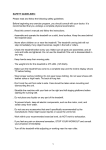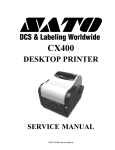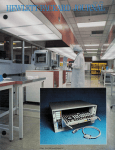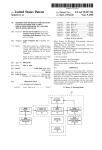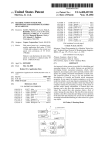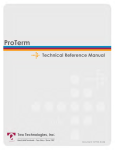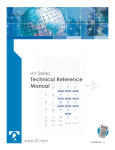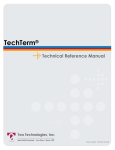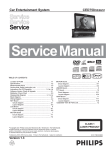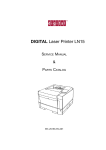Download SATO CX400 Technical information
Transcript
CX400 Technical Manual (Rev 1.00) CX400 Technical Manual Rev 1.00 Except as may otherwise be provided by contract, this document contains proprietary technical information which is the property of BARCODE SATO INTERNATIONAL PTE Ltd.& ARGOX Information Co., Ltd and is strictly confidential and shall not be disclosed to others in whole or in part, reproduced, copied or used as a basis for design, manufacturing, or sale of apparatus without the written permission of BARCODE SATO INTERNATIONAL PTE Ltd or ARGOX Information Co.,Ltd. SATO /ARGOX Technical Documentation Confidential Information 1 CX400 Technical Manual (Rev 1.00) 1. GENERAL INTRODUCTION................................................................................................................. 3 2.PRINTER SPECIFICATION.................................................................................................................... 3 2.1 Electronic .......................................................................................................................................................................................................... 3 2.2 Printing .............................................................................................................................................................................................................. 3 2.3 Fonts.................................................................................................................................................................................................................. 3 2.4 Bar code............................................................................................................................................................................................................ 3 2.5 Graphic ............................................................................................................................................................................................................... 4 2.6 Media ................................................................................................................................................................................................................. 4 2.7 Operating environment.................................................................................................................................................................................. 4 2.8 Physical dimension ......................................................................................................................................................................................... 4 2.9 Communication specifications...................................................................................................................................................................... 4 3. CONTROLS AND INDICATORS........................................................................................................... 7 3.1 Front panel ........................................................................................................................................................................................................ 7 3.2 Rear panel .......................................................................................................................................................................................................... 7 4.OPTIONAL ACCESSORIES..................................................................................................................... 9 4.1 Cutter mechanism ............................................................................................................................................................................................ 9 4.2. FONT module................................................................................................................................................................................................. 9 4.3. Dispenser........................................................................................................................................................................................................... 9 5. SELF-DIAGNOSIS AND CALIBRATION......................................................................................... 10 5.1 Self Diagnosis .................................................................................................................................................................................................10 5.2 Calibration ................................................................................................................................................................................................11 6. OPTIONAL PARTS INSTALLATIONS............................................................................................. 14 6.1 Cutter Installation..........................................................................................................................................................................................14 6.2 Dispenser installation....................................................................................................................................................................................17 7. FIRMWARE UPGRADING.................................................................................................................. 19 7.1 Unzip Firmware File ..................................................................................................................................................................................19 7.2 Upgrade F irmware in Normal Case..........................................................................................................................................................19 7.3 Upgrade Firmware in Corrupted Case....................................................................................................................................................19 8. MAINTENANCE AND TROUBLE SHOOTING................................................................................ 21 8.1 Printer status indication................................................................................................................................................................................21 8.2 Trouble Shooting............................................................................................................................................................................................22 8.3 Clearance ........................................................................................................................................................................................................26 8.4 Replacement ...................................................................................................................................................................................................27 9. OPERATIONAL THEOREM................................................................................................................. 34 9.1 9.2 9.3 9.4 9.5 9.6 9.7 System block diagram...................................................................................................................................................................................34 Block Diagram of Main Control Board ..................................................................................................................................................36 Schematic of Main Control Board ...........................................................................................................................................................38 Schematic of Panel Board ...........................................................................................................................................................................40 Schematic of Various Sensor Boards.....................................................................................................................................................40 Wiring Diagram.............................................................................................................................................................................................41 Exploded Drawing ........................................................................................................................................................................................42 10. “MAJOR” & “RECOMMENDED SPARE” PARTS ........................................................................ 45 SATO /ARGOX Technical Documentation Confidential Information 2 CX400 Technical Manual (Rev 1.00) 1. GENERAL INTRODUCTION Scope: This Technical manual covers the information for properly maintaining SATO CX 400 Label Printer, such as, “ Printer specification”,“Trouble Shooting Guide”, “Option Accessory Installation “,” Spare Parts List”, “Set up & Diagnosis“, “working theorem” and so on. For the issues related to soft ware, please refer to “Programmer Manual” Related manuals: n n User’s manual Programmer’s manual 2.Printer Specification 2.1 Electronic CPU …………………………………………………... Hitachi SH7034 C LOCK ……………………………………………… 20 M Hz ( 26 MIPS ) Panel ………………………………………………… 1 Green LED for Power & 1 Red LED for Error Indication, 1 Feed Button DRAM……………………………………………….. 1 M word Flash ROM …………………………………………. 1 M word ( 2 x 1 M byte ) Sensors……………………………………………… 1. I-mark( Reflective ) and Gap(See-Through) Sensor for detecting the index on media 2. Ribbon, Dispenser Sensor 3. Printer Head Open Sensor Power Input…………………………………………. RMS 19V AC Input to the Power Jack on Printer Power Consumption in printing …………………. 70 Watt . Power Consumption in Standby…………………… Less than 2 Watt Regulatory Approvals……………………………….. FCC Class B,CE, TUV,CCC,UL Additional Memory …………………………………. 2 M or 4 M byte Flash ROM 2.2 Printing Method Resolution Max print width Max print length Print speed : : : : : Thermal Transfer and Direct thermal 203 dots/inch (8 dots/mm) 4.1”(104mm) 1270 mm ( 50 inches ) 1,2,3,4 inches per second specified by SATO printer command . This Printer might slow down the printing speed to 3~2 IPS or pause printing upon Stepping Motor or Print Head is over-he at. Printing will be resumed to the specified speed when Motor or Print Head is cooled down again. Normally the mechanism for over-heat protection will be NOT activated before 2 rolls of labels (more than 150 meters l ong.) are printed out consecutively in 4 IPS mode. 2.3 Fonts Text fonts: Rotation: Compatible with all SATO CL printers Code Page 858, Others available. U;S; M; WB; WL; XU; XS; XM; XB; XL; OCR-A/B; Outline Font (50 ~ 999 dots) 0, 90, 180, 270 degree, 4 direction rotation 2.4 Bar code UPC A/E, EAN8/13, EAN128, Code39, Code93, MSI, I25, M25, Postnet Bookland, Code 128, UCC 128, Codabar, MaxiCode, PDF417 SATO /ARGOX Technical Documentation Confidential Information 3 CX400 Technical Manual (Rev 1.00) 2.5 Graphic Formats: Rotation: SATO Hex/Binary 0o; 90 o; 180 o; 270 o 2.6 Media Media type : Direct Thermal - direct thermal paper or vinyl, visible light and infrared scannable label, tag stock, with various adhesives. Thermal transfer - all above media, plus thermal transfer paper Max Label Roll Diameter : 127mm ( 5” ) Label Roll Core Diameter : 19.05 mm ( 0.75” ) Min. Inter-Label Gap : 2 mm ( 0.08” ) Max. Inter-label Gap : 25.4 mm ( 1“ ) Media Sensor: 1. Either “Reflective Sensor” or “Gap/I-mark Sensor” can be selected by user. 2. Located in the left side of Label Guide. In other words, the sensors are moved with the label width. 3. Gap/I-mark Sensor is for the Labels with Die-Cut gap or Notched Index . Reflective Sensor is for the Labels with Eye-Mark, Die-Cut gap. 2.7 Operating environment Electrical: AC 90VAC to 250VAC 50-60 Hz Operating: +5 ~ 38oC ( 25 ~ 85 RH, non condensing ) Storage: -20 ~60oC( 25 ~ 85 RH, non condensing ) 2.8 Physical dimension Weight : Size : 3.67kg ( Transformer Adaptor Included ) 197mm (7.76”) x 257mm (10.2”) x 164mm (6.5”) 2.9 Communication specifications SATO CX-400 Label printers send and receive messages through either serial or parallel communication interface. Printer will automatically monitor these two ports for receiving commands/data from Host. SATO /ARGOX Technical Documentation Confidential Information 4 CX400 Technical Manual (Rev 1.00) 2.9.1 Serial interface specification The serial interface of CX400 printer is a RS-232C port with standard 9- pin (DB9-S) connector located at the rear of the printer. CX400 printers employed “Flow Control” mechanism with either RTS/CTS or X-on/X-off (control characters are DC2 and DC4). The parameters can be set by printer are as followings, Speed: 9600, 19200 or 38400 baud Parity: Odd, Even, or None Data Bits: 7 or 8 bits Stop Bit(s) 1 or 2 bits Default parameters: 9600 bauds, no parity, 8 data bits, 1 stop bit Pin Signal Description 1 Carrier Detection “Shorted with Pin 9” ( RI ) or” Open” count on R94 existed or not 0 Ohm on R94 è Shorted with Pin 9 (+5 V ) No Resistor on R94 è Pin 1 is N.C. 2 Received Data, RxD Input. Serial “Received Data” 3 Transmitted Data, TxD Output. Serial “Transmitted Data”. 4 Data Terminal Ready, DTR Always maintai n at high state ( +10 V ) 5 GND Signal Ground 6 Data Set Ready, DSR Shorted with Pin 4 (DTR) 7 Request to Send ,RTS Output. Used as the control signal for “H/W Flow Control “ 8 Clear to Send , CTS Input. Used as the control signal for “H/W Flow Control” 9 Ring Indicator, RI “5 Volt” or “N.C. selected by JP1 on board “0 ohm “ puts on JP1 è “5 V” No resistor on JP1 è NC Table 2.1 Note: CX400 printers require a “null modem” cable (pin 2-3 and 7-8 crossed wiring) while connecting to another DTE Device, like PC. SATO /ARGOX Technical Documentation Confidential Information 5 CX400 Technical Manual (Rev 1.00) 2.9.2 Parallel interface specification This port complies with IEEE-1284 Compatibility mode( Also named as Standard Parallel or Centronic Port ). 2.9.3 Pin assignment and descriptio n Pin Signal Description 1 /STROBE Input. Active low pulse used to transfer data into the printer. D1~D8 Pin 2 à D1.. Pin 9 à D8 Data Input 10 Acknowledge, /ACK Output. Active low pulse indicates that data has been received and the printer is ready to accept more 11 BUSY Output. A high signal indicates that the printer cannot receive data. 12 Paper End, PE Output. A high signal indicates that the printer is out of paper 13 Select (high) Always maintain at +5 V 14 Supply Ground N.C. 15 Oscillator Transmit N.C. 16 Logical Ground GND 17 Chassis Ground GND 18 +5 Vdc N.C. 2~9 19~30 GND 31 Input Prime (low) N.C. 32 /FAULT Output. A low signal indicates that the printer is in error state 33~36 - N.C. Table 2.2 SATO /ARGOX Technical Documentation Confidential Information 6 CX400 Technical Manual (Rev 1.00) 3. CONTROLS AND INDICATORS 3.1 Front panel Power indicator Error indicator Feed Button Power Switch Figure 3.1 POWER indicator The POWER indicator remains ON when the AC power switch is in ON position except “ Ribbon O ut”, “Media Out” , or other errors occur. It will blink when those errors are detected. ERROR indicator It will start to blink while “M edia Out“, “Media Gap Not Found”, “Ribbon Out “ or other errors being detected. The followings list the meaning for diverse LED indication, 1. 2. 3. 4. 5. ERROR LED is OFF and POWER LED is ON while there are no errors detected by Printer. “ERROR &POWER LED synchronously blinking” indicate “Media Error”, either “No Media”or “ Media Index not Found” “ERROR & POWER LED reversely blinking“ indicates “Ribbon Out”. “POWER LED ON and ERROR LED blinking , longer OFF period than ON period” indicates “Print-head Open”. “POWER LED ON and ERROR LED blinking at the same ON and OFF period” stands for other errors , like RS232 communication error. FEED Key 1. 2. 3. 4. Pressing the button during start -up, a test label will be printed out. Pressing the button during printing will cause the printing to be paused. To feed a blank label or print the last printed label. To reset this printer to factory settings. Power switch Turn on/off printer. 3.2 Rear panel Centronics connector (parallel port) For parallel port connection . Mostly it is connected to the printer port of a PC . RS232 connector (serial port) For serial port connection . Mostly it is connected to the COM port of a PC . SATO /ARGOX Technical Documentation Confidential Information 7 CX400 Technical Manual (Rev 1.00) Power Jack To connect the Power Plug from Power Adaptor USB Reserved Parallel Port External Media Feed Knockout Power Jack for 19 V AC Input RS232 Port Figure 3.2 Wall Mount Slots SATO /ARGOX Technical Documentation Confidential Information 8 CX400 Technical Manual (Rev 1.00) 4.Optional Accessories 4.1 Cutter mechanism Optional cutter for cutting labels, tags or tickets . Back feed is included for cutting . 4.2. FONT module Font module, which is used to store special font such as Chinese, Korean, Japanese characters. The total size of Font Module could be 4 M or 2 M bytes. 4.3. Dispenser Dispenser provides the automatic peel-off function . SATO /ARGOX Technical Documentation Confidential Information 9 CX400 Technical Manual (Rev 1.00) 5. Self-Diagnosis and Calibration 5.1 Self Diagnosis A simple Self-Diagnosis could be activated by either a group of Printer Commands or Feed Button. A. By Commands 1. Edit a text file that includes the following commands. <ESC>A <ESC>CT <ESC>Z 2. B. Send the file to printer. Then a “ Self Test Label” will be printed out. By FEED Button 1. 2. 3. Press and hold the FEED button till the printer starting to print “Self Teest Label” shown on Fig. 5.1. Release the FEED button. Cycle printer power to resume this printer to normal mode. ( It is necessary to cycle Printer Power since the printer will be in “HEX dump mode” After the test label is printed out ) The Contents and Information in “Self Test Label” are as followings, 1. Image Pattern Used to check the print head, motor, roller and related mechanical parts. 2. Version Information This includes date code, firmware version and check sum value. Note that the check sum value should be 0000 otherwise it implies there are error bits in the onboard flash memory. 3. RS232 Protocols It contains baud rate, parity, data bit number and stop bit number. 4. Darkness Default darkness. It can be overwritten by a darkness command. 5. Accumulated Print length It keeps the length printed in inches. By this you may check the print head warranty. But it cannot be reset when you replace the print head or any components. 6. Print Speed Default print speed in IPS. The factory default is 3 IPS. 7. Media Sensor Used It specifies the sensor type used for media, I-mark( Reflective), Gap ( See-Through ) or disabled. Select the proper one for your media by command or through the application software. 8. Print Mode It is either TT (Thermal Transfer with ribbon) mode or DT (Direct Thermal without ribbon) mode. 9. Tear-Off Option It indicates whether “back feed” is taken for tearing off the printed labels. 10. Control Code Definition It shows the control code set. The control codes affect the commands and special controls. SATO /ARGOX Technical Documentation Confidential Information 10 CX400 Technical Manual (Rev 1.00) 11. Pitch Offset The offset value affects the start print position. 12. Accumulated Cut Count This is used to check the cutter life. 13. Memory Slot I This is the onboard non-volatile memory, flash memory used to store the graphic, font objects. The size of memory slot I is 512K bytes. 14. Memory Slot II This is the optional non-volatile memory, flash memory used to store the graphic, font objects. The size of memory slot II is either 2M or 4M bytes. 2 1 3 4 5 6 7 8 9 10 12 11 13 14 Figure 5.1 < Important !> The printer will be in hex dump mode after printing the self-test label. It cannot print normal labels in hex dump mode. The printer will return to normal operation only you cycle power for restarting this printer. 5.2 Calibration CX400 unit had been calibrated at the factory for using with SATO standard ribbon and media. Other ribbon/media combinations may or may not index properly with these settings. You might need to perform various calibrations to adapt the variance caused by the particular Media & Ribbon. 5.2.1 To Calibrate Media Sensor You might need to perform “Media Sensor Calibration” if Printer frequently skips a blank label, the variance for “Printing position” in every label is too obvious, or the image on printed label is not located as what you set. The Calibration for media sensor can be done by clicking the Calibration Buttons in the Label Wizard CX software or the Windows Printer Driver. If it is not convenient for you to calibrate Media Sensor with those application software, this sensor calibration also can be performed by directly sending “ Printer Commands for Media Sensor Calibration” to printer. 1. Install well the Media and Ribbon ( TT mode ) 2. You can calibrate the Media Sensor with Application S/W. SATO /ARGOX Technical Documentation Confidential Information 11 CX400 Technical Manual (Rev 1.00) Or you are also able to directly send out a group of commands to printer for calibrating the media sensors in either Imark(Reflective )or Gap(See-Through ) mode. Two groups of commands for Bar & Gap mode sensor are listed below, <In Reflective mode > <ESC>A <ESC >CI1 <ESC>CA <ESC>Z < In Gap mode > <ESC>A <ESC>CI2 <ESC>CA <ESC>Z 3. Once the Media sensor calibration is activated in step 2, the printer will feed several labels ( 6 inches) to perform this calibration. After this printer completely stops feeding label, this calibration had been well. < note 1 > < ESC> = 0x1B, < note 2 > The ribbon must be installed in the printer when calibrating in the thermal transfer mode. Printhead Open Sensor Media Sensor Ribbon Sensor Print Head(TPH) Figure 5.2 SATO /ARGOX Technical Documentation Confidential Information 12 CX400 Technical Manual (Rev 1.00) 5.2.2 Calibration for Ribbon Sensor The calibration for Ribbon sensor might need to be performed while the particular Ribbon & Media you installed makes this printer fails to detect ribbon out or the end of ribbon. Actually it is not necessary to perform this calibration except the installed Ribbon & Media are very particular. The calibration for ribbon sensor is used for the printer to keep the characteristics of ribbon sensor, ribbon and media. The printer always checks the ribbon existence during printing under TT (thermal transfer) mode. Once the printer mis-detects the ribbon you must make a ribbon calibration for them. Two steps are required to do it. Step 1 è To Install both Ribbon and Media , then 1. Send a group of commands to the printer. <ESC>A <ESC>&I1 <ESC>Z 2. Wait for five seconds to make sure the printer to finish checking. Step 2 è Remove the Ribbon and Install the Media,then 1. Send a group of commands to the printer. <ESC>A <ESC>&I0 <ESC>Z 2. Wait for five seconds to make sure the printer to finish checking. After Step1&2 have been done the calibration ribbon sensor is completed. <Note>You can also put the end-mark ribbon (in general it is in silver color) under the ribbon sensor (right under print head) at step B. 5.2.3 Calibration for Dispenser Sensor The calibration for dispensor sensor is used for the printer to keep the characteristics of dispensor sensor and media. The printer checks the label existence after printing, when the printed label is removed the printer continues printing for the next label automatically. Once the printer mis-detects the label you must make a calibration for them. Two steps are required to do it. Step 1 è Putting a label on the plastic plain under the dispenser sensor, then 1. Send a group of commands to the printer. <ESC>A <ESC>&P1 <ESC>Z 2. Wait for five seconds to make sure the printer to finish checking. Step 2 è Removing the label from the dispenser sensor, then 1. Send a group of commands to the printer. <ESC>A <ESC>&P0 <ESC>Z 2. Wait for five seconds to make sure the printer to finish checking. After both above steps 1&2 have been done the calibration for dispenser is completed. SATO /ARGOX Technical Documentation Confidential Information 13 CX400 Technical Manual (Rev 1.00) 6. OPTIONAL PARTS INSTALLATIONS CAUTION The printer electronics are susceptible to static discharge . Wear an anti-static wrist and attach it to the printer chassis 6.1 Cutter Installation 1. 2. 3. 4. Turn off the power switch Loose the 2 screws( B ) to take off “Peeler Cover”(75). Loose the screw ( E) which screwed “ANG-PEELER” (28) to “Printer Chassis”(30). Push “ANG-PEELER”(28) to right then take it out. Figure 6. 1 SATO /ARGOX Technical Documentation Confidential Information 14 CX400 Technical Manual (Rev 1.00) 5. 6. 7. 8. Loose the 2 screws( I ) on Printer Bottom Pull out the front side of “Middle Cover” ( 96 ) then remove it from “Bottom”(39) Unplug “Power Switch” from “Power Cords” then take out “Middle Cover”(96) Put “Baby Board” to JP29 on the main board Figure 6.2 SATO /ARGOX Technical Documentation Confidential Information 15 CX400 Technical Manual (Rev 1.00) 9. 10. 11. 12. 13. Let the 2 Power Cords go through the switch hole on “Middle Cover”, then plug “Power Cord” to Power Switch. Pull the front side of “ middle cover” to put it back on “Bottom” (39). Screw up the 2 screws(I) on Printer Bottom. Plug the cutter cable to “External Connector” as shown on Figure 6-3. Insert “Cutter Module” into the slot on “Printer Chassis”(30) where you took off “ANG-PEELER”(28) in “step 4”. 14. Screw “Cutter Module “ on “Printer Chassis”(30) wit h screw (B). 15. Click back “Print Head” and Click back “Top Cover” 16. After cutter had been installed well with the above steps, you still need to set the E2PROM through commands. <esc>A <esc>CK1 <esc>Z Once the cutter is uninstalled you also need change the setting by commands or make a reset from panel. <esc>A <esc>CK0 <esc>Z Figure 6-3 SATO /ARGOX Technical Documentation Confidential Information 16 CX400 Technical Manual (Rev 1.00) 6.2 Dispenser installation 1. 2. 3. Turn off the power switch. Loose the screw (E). Loose the 2 screws( B ) to take off “Peeler Cover”(75). Figure 6.4 SATO /ARGOX Technical Documentation Confidential Information 17 CX400 Technical Manual (Rev 1.00) 4. 5. 6. 7. 8. Plug “Sensor cable” of Dispensor Module into “External Connector” Screw Dispensor Module on “Printer Chassis” with 2 Screw(B ) Screw “Sensor Cable” on “Printer Chassis ” with the screw (E ) Click back “Dispensor Module”. Click back “Printer Head “ & “Top Cover” Figure 6. 5 SATO /ARGOX Technical Documentation Confidential Information 18 CX400 Technical Manual (Rev 1.00) 7. FIRMWARE UPGRADING The firmware in Printer CX400 is able to be upgraded through the Centronic port on printer. The following sub-section describe how to upgrade firmware in normal and corrupted case 7.1 Unzip Firmware File This diskette(ZIP file) contains the related files and data that you may change or upgrade the firmware. Before changing the firmware decompress the file first. 1. 2. 3. 4. C:\>MD SATO C:\>CD SATO C:\SATO >COPY A:README.TXT C:\SATO >A:PKUNZIP A:CX400_Vx.xx.ZIP è Decompress all the files for upgrading F/W ( Where “x.xx” is version number ,e.g. 1.01 ) 7.2 Upgrade Firmware in Normal Case 1. 2. 3. 4. 5. 6. Turn on the printer and wait for 3 seconds. Set PC to MS-DOS . CD C:\SATO ( Change the Directory you made in 8.1 section ) Enter “SATO” on the DOS prompt “c:\SATO” Wait a moment ( 2~3 minutes ) till “Power & Error LED” are synchronously blinking for completing F/W upgrade. Then cycle the printer power to restart this printer. When up date successfully, please follow the reset procedure listed in section 5.1 to reset this printer and verify if this upgrade is successful or not. Specially the check sum in the label, which were printed out during reset, should be 0000. 7.3 Upgrade Firmware in Corrupted Case In very abnormal case, the Boot -Up program located at BOOT sector of Flash ROM in CX400 might be corrupted(Supposedly it is impossible to happen. ). This will cause Printer to be unable to perform F/W upgrade with the above normal way. In this case you might need to refer below to upgrade the Firmware. 1. Refer to step 1~2 and Step 5~8 in section 8.4.3 to disassemble this Printer till the expansion slot ( JP11)& JP5 is accessible. 2. All the jumpers on JP5 (Located beside Expansion slot,J P11, and U8,U9) should be put on BOOTER side. 3. Put “Booter Module“( It is the normal Font Card with “Booter Firm Ware” but not with Fonts. ) on JP11. 4. Turn on the printer and wait till POWER LED lights up. 5.. Set PC to MS-DOS. 6. CD C:\SATO ( Change the Directory you made in 7.1 section ) 7. Enter “SatoBoot” on DOS Prompt “c:\SATO” . 8. Wait around 1 minute till Power” & “Error” LEDs are synchronously & slowly blinking. Then turn off this printer. 9. Put all the jumpers on JP5 to be at NORMAL side again. 10. Remove “Booter Module” from JP11. 11. Refer to section step 19~21 and step 24~25 in section 8.4.3 to assembly this printer. 12. Follow the reset procedure listed in section 5.1 to reset this printer and verify if this upgrad being successful or not. Specially the check sum in the label, which printed out during reset, should be 0000. Note: 1. It is prohibited to run under Windows DOS for upgrading F/w in the above 2 modes 2. DO NOT TURN OFF the printer during changing the firmware till “POWER and ERROR LED” are synchronously blinking. Otherwise unpredictable results may occur. SATO /ARGOX Technical Documentation Confidential Information 19 CX400 Technical Manual (Rev 1.00) 3. The binary file downloaded to CX400 for updating the F/W in corrupted case must be led with the prefix commands. “Prefixed commands + binary data” can be sent to CX400 by entering “ Copy <prefix Commands file>+< Binary Data file> LPT1: “ in DOS prompt. The syntax of Prefix is : <Prefix >: 0x1B+0x24+0x33+"Start offset(1 byte)"+"Data Count(1 byte)" "Start offset" èTo Define the Starting offset for programming the On-Board Flash ROM. The actually Starting Offset is got by multiplying "Start offset(1 byte)" with (2** 16 ). By the way CHIP ERASE is performed only when "Start Offset"is set to zero. "Data Count" è To Define the Data Count in the following Binary Data. The actually Data Count is got by multiplying "Data Count" with (2** 14 ). < e.g. > 1. 0x1B+0x24+0x33+0x00+0x04 + " Binary Data programmed on Flash ROM" è Send the above data to Printer, then thhe Binary Data will be stored on Flash ROM from offset 0x000000 to 0x00ffff. 2. 0x1B+0x24+0x33+0x20+0x40 + " Binary Data programmed on Flash ROM" è The Binary Data will be stored on Flash ROM from 0x200000 to 0x2fffff. 3. 0x1B+0x24+0x33+0x00+0x80 + "Binary Data programmed on Flash ROM". è The Binary Data will be stored on Flash ROM SATO /ARGOX Technical Documentation Confidential Information 20 CX400 Technical Manual (Rev 1.00) 8. Maintenance and Trouble Shooting 8.1 Printer status indication The printer has built -in monitors for the status. The status and error indications will be displayed on the front panel LED indicators. Generally, when a malfunction or an abnormal condition being detected, the ERROR LED will blink. Tab. 8.1 below shows the LED indications corresponding to various errors. LED Indication Description ERROR LED are synchronously blinking Indicate “ Fail to detect Media Index or Media out“. with POWER LED ( on & off in the same time ) ERROR LED is Blinking in the opposite way Ribbon Error with POWER LED ERROR LED is ON and OFF alternatively Print Head Open.. and the OFF period is longer than ON, when POWER LED being ON. “POWER LED ON and ERROR LED RS232 error. blinking at 50 % duty cycle Table 8.1 CAUTION The printer electronics are susceptible to static discharge . Wear an anti-static wrist and attach it to the printer chassis SATO /ARGOX Technical Documentation Confidential Information 21 CX400 Technical Manual (Rev 1.00) 8.2 Trouble Shooting < I. Power Fail > LED Indication Both Power & Error are Off Status No Power 1. 2. 3. 4. Cause No Power Supplied The fuse in Adaptor was burned out Printer might be out of order. “Main board “ or “ Panel Board “ Bad Adaptor might be Bad Turn Off Printer Power Connected or AC Power on Outlet ? No Connect Power Yes Is Power Switch on? No Switch ON Yes Open the Cover of Power Adaptor Is Fuse in Adaptor Burned-out? YES Replace the fuse. No “Main Control Board” , “Panel Board” or “Power Adaptor” is Out of Order SATO /ARGOX Technical Documentation Turn on Switch to Check if Problem being Fixe Confidential Information 22 CX400 Technical Manual (Rev 1.00) < II. Media Error > LED Indication ERROR LED is synchronously blinking with POWER LED Status Media Error 1. 2. 3. 4. Cause Media out (No Media detected ) Media Jammed Special Media. Need Calibration Media Sensor might be out of order Turn Off Printer Out ofofmedia ? Out Media? Load a new media roll Yes No Yes Mediastuck stuck Media or jammed Jammed Remove the Stuck Or Jammed Media No Media Loaded Correctly? No Reload Media Yes Is Media Put Along the Bound of Paper Guide ? Yes Using Continuous Media? Yes Disable Index Detection Yes No No Put the Media Along the Bound of Paper Guide Calibrate Media Sensor Still Media Error? No Yes 1. 2. Media Sensor might be Out of Order Check the Mechanism regarding Media Detection SATO /ARGOX Technical Documentation Turn On then Print Print again Confidential Information 23 CX400 Technical Manual (Rev 1.00) < III. Ribbon Error > LED Indication ERROR LED is blinking in the opposite way with POWER LED Status Ribbon Error 1. 2. 3. 4. Cause Ribbon out Ribbon Stuck Special Ribbon & Media. Need Calibration. Ribbon Sensor might be out of order Turn Off Printer Out of Ribbon ? Yes Load a New Ribbon No Ribbon Stuck or Jammed ? Yes Remove the stuck or Jammed Ribbon No Calibrate Ribbon Sensor Still Ribbon Error ? No Yes 1. Ribbon Sensor might be Out of Order 2. Check the Mechanism Regarding Ribbon Detection SATO /ARGOX Technical Documentation Turn on Printer Then Print again Confidential Information 24 CX400 Technical Manual (Rev 1.00) < III.. RS232 Error > LED Signal “POWER LED ON” and “ERROR LED blinking at 50 % duty cycle “ Status RS232 Error 1. Cause The Settings for RS232 between Host & Printer are not consistent Switch power off Is baud rate consistent in PC & Printer? No Set the same Baud Rate in PC & Printer No Set the same Data ? Printer Bit in PC & Yes Is Data Bit consistent in PC & Printer? Yes Is Parity bit consistent in PC & Printer? No Set the same Parity ? Printer Bit in PC & Switch power on then print SATO /ARGOX Technical Documentation Confidential Information 25 CX400 Technical Manual (Rev 1.00) 8.3 Clearance CAUTION The printer electronics are susceptible to static discharge. Wear an anti-static wrist and attach it to the printer chassis There are some components need to be clean-up occasionally : Thermal print head The debris of thermal paper or ribbon may be remained on the print head. This will cause the printed image (Characters, Bar Code … )to appear light or faded . To clean the print head, wet a soft paper towel with “isopropyl rubbing alcohol” and use the damp towel to rub off the dirt on the print head surface . It is recommended to clean “Print Head” before a new ribbon being loaded. Platen roller : If the roller becomes contaminated with grit, label adhesive, or ink, the printing quality may be adversely affected. To clean the roller , using a clean cloth and alcohol, wipe off any accumulated debris . Note : Switch off the power before cleaning ! SATO /ARGOX Technical Documentation Confidential Information 26 CX400 Technical Manual (Rev 1.00) 8.4 Replacement 8.4.1 Printing Head( TPH ) Replacement CAUTION The printer electronics are susceptible to static discharge. Wear an anti-static wrist and attach it to the printer chassis 1. 2. 3. Turn Off Printer Push “Print Head module” and pull it down as the 2 arrows shown in Fig. 9.1 to release “Print Head module” from “Printer Chassis”(30). Loose the 4 screws( C ) to take out Print Head from “Print Head Module “(12 ,13). Figure 8.1 SATO /ARGOX Technical Documentation Confidential Information 27 CX400 Technical Manual (Rev 1.00) 4. 5. 6. 7. Unplug the 2 Print Head cables from the connectors on Print Head to take off the old Print Head. Plug the 2 Print Head cable to the new Print Head. Screw the new Print Head on “Print Head module”(12,13) . Put back new “Print Head module” on “Printer Chassis”(30) with the same way which you released it from “Printer Chassis” Figure 8.2 8.4.2 Main-Board Replacement 1. 2. Turn off Printer Loose the 2 screws( B ) to take off “Peeler Cover”(75). Figure 8.3 SATO /ARGOX Technical Documentation Confidential Information 28 CX400 Technical Manual (Rev 1.00) 3. 4. 5. 6. Loose 2 screws( I ) on Printer Bottom( 39 ). Pull out the front side of “Middle Cover“ (96), then remove it from “Printer Bottom” ( 39 ). Use a proper screw driver (I type, as sharp as possible ) to loose “Power Switch” which is locked on “Middle Cover”(96). Unplug “Power Switch” from “Power Cords” then take out “Middle Cover” (96 ). Figure 8.4 SATO /ARGOX Technical Documentation Confidential Information 29 CX400 Technical Manual (Rev 1.00) 7. 8. 9. 10. 11. 12. 13. 14. 15. 16. 17. 18. Loose 4 screws ( E ). Unplug all the connectors which connected on Main Board . Then take out the “Printer Chassis” ( 30 ) . Loose those 4 screws ( B ) which fixed Main-Board (80) on Bottom ( 39 ). Then take out the Bad Main-Board. Put the new main on Bottom(39). Then Screw up those 4 screws ( B ) on Printer Bottom ( 39). Plug the female connectors, which attached on “P rinter Chassis”( 30 ) with cables, into the corresponding male connectors ( Its color & Pin Count are identical with the female connector ) on Main Board. Put “Printer Chassis”(30) on Bottom(39). Screw up 4 screws (E ) to fix “Printer Chassis” (30 ) on Bottom(39). Let the 2 Power Cords go through the switch hole on “Middle Cover”(96), then plug “Power Cord” to Power Switch. Pull the front side of “middle cover ” to put it back on “Bottom” (39). Screw up the 2 screws(I) on Printer Bottom . Screw up the 2 screws( B ) to install “Peeler Cover”(75) on “Printer Chassis”(30). Press and click “Power Switch” into the switch hole on “Middle Cover”(96). Figure 8.5 SATO /ARGOX Technical Documentation Confidential Information 30 CX400 Technical Manual (Rev 1.00) 8.4.3 Roller Replacement 1. 2. 3. 4. Turn off Printer Loose the 2 screws( B ) to take off “Peeler Cover”(75). Loose the screw ( E) which screwed “ANG-PEELER” (28) to “Printer Chassis”(30). Push “ANG-PEELER”(28) to right then take it out. Fig. 8.6 SATO /ARGOX Technical Documentation Confidential Information 31 CX400 Technical Manual (Rev 1.00) 5. 6. 7. 8. Loose 2 screws( I ) on ‘Printer Bottom’( 39 ). Pull out the front side of “Middle Cover“ (96), then remove it from “Printer Bottom” ( 39 ). Use a proper screw driver ( I type, as sharp as possible ) to loose “Power Switch” which is locked on “Middle Cover”(96). Unplug “Power Switch” from “Power Cords” then take out “Middle Cover” (96 ). Fig. 8.7 SATO /ARGOX Technical Documentation Confidential Information 32 CX400 Technical Manual (Rev 1.00) 9. 10. 11. 12. 13. 14. 15. 16. 17. 18. 19. 20. 21. 22. 23. 24. Take out “ E Ring ( X )” to remove Gear (67) . Loose Screw ( B ). Take out the 2 “BUSH -ROOLER” ( 26 ) which ringed the ROLLER (27 ) shaft . Move ROLLER ( 27 ) to the most left side then pull it out. Then take out the BUSH-ROLLER (26) which is adhered to the Right Shaft of ROLLER(27). Put the BUSH -ROLLER, which take out from step 11,into the right shaft ( Shorter one ) of new ROLLER. Put the Left Shaft of new ROLLER (27)( Longer shaft ) into the Roller Hole at the left side of “Printer Chassis”, then push the right Shaft( Shorter Shaft ) into the Roller Hole at the right side of “Printer Chassis”(30). Put 2 BUSH-ROLLER (26 ) into the left Shaft of New ROLLER ( 27 ) Fix New “ROLLER”(27) in “Printer Chassis”(30) with Screw (B ). Put back Gear ( 67 ) then fix it with “E ring “. Let the 2 Power Cords go through the switch hole on “Middle Cover”(96), then plug “Power Cord” to “Power Switch”. Pull the front side of “ middle cover” to put it back on “Bottom” (39). Screw up 2 screws(I) on Printer Bottom. Push righ “ANG-PEELER”(28) to put it into “Printer Chassis”(30). Fix “ANG-PEELER” to “Printer Chassis”(30) with “SCREW (E )” . Screw up 2 screws( B ) to fix “Peeler Cover”(75) on “Printer Chassis”(30). Press and click “Power Switch” into the switch hole on “Middle Cover”(96). Fig. 8.8 SATO /ARGOX Technical Documentation Confidential Information 33 CX400 Technical Manual (Rev 1.00) 9. OPERATIONAL THEOREM 9.1 System block diagram Panel Board Ribbon Sensor IEEE 1284 SPP Main Board Dispensor sensor Thermal Print Head RS232 ( 9 pin ) Cutter Media sensor Roller Stepping Motor Printer Head Open Sensor External ACAdaptor Figure 9.1 CX400 System Block Diagram The major modules in CX400 are, Main board : A four layers PCBA ,which consists of a micro-controller ,Flash ROM ,EEPROM , DRAM …… components required for the printing functions. Panel board : A 2 layers PCBA consists of one push button switches and two LED indicators. Ribbon sensor : A 2 layer PCBA , consists of a reflective type object sensor designate for ribbon detection. Media sensor A 2 layer PCBA, which consists of a reflective and see-through object sensor designates for media/gap detection. SATO /ARGOX Technical Documentation Confidential Information 34 CX400 Technical Manual (Rev 1.00) Thermal print head (TPH) This Print Head is consisted of 864 heat elements( 800 Ohm for each element) in the printing width of 4 inches. Stepping Motor : The motor for feeding label and ribbon is a stepping motor with Bipolar winding & PM type. Its rotary angles in one full step is 7.5 degree. Dispenser Sensor (option) An two layer PCBA , consist of a reflective type object sensor designate to detect the printed label is removed or still exist . Cutter assembly (option) Consisting of a DC motor, relay ,gears and a rotary cutter . This cutter is able to be applied in cutting the printed label automatically. SATO /ARGOX Technical Documentation Confidential Information 35 CX400 Technical Manual (Rev 1.00) 9.2 Block Diagram of Main Control Board CS7 Input Port 74374 ( U13) Flash ROM ( U8,U 9 ) SYSTEM SLOT ( JP11 ) BUS BUS EXPANSION CPU (SH7034 ,U6 ) DRAM ( U10 ) SYSTEM RAS,CAS Data IEEE1284 SPP( P1 ) PE/Fault CS4 D15~8 74374 (U11 ) D7~0 Cutter Baby Board (JP29) Output Port-High Driver, 3717 (U16,17 ) Output Port -Low 74374 (U15 ) MOTOR ( JP17) LED ( JP16 ) Paper Sensor Control ( JP2,JP15) 24 V Relay (RY2) RS232 RS232 T Tranceiver SP232ACT ? ( U2 ) (P2) Feed Key ( JP16) EEPROM ( U7 ) Booter/ Normal ( JP5 ) Paper Sensor (JP15) Ribbon Sensor (JP14 ) Dispensor Sensor (JP12 ) Config. Jumper ( JP7 ) Cutter Sensor ( JP13 ) Motor T.M. ( JP4 ) Strobe Data/CLK TPH ( JP18 ) Figure 9.2 The major Components in Main Controller are: Micro-controller (U6) SH7034 ( External 16 Bit & Internal 32 Bit in Data Bus) is based on Hitachi SH1 as its CPU Kernel and integrated with lots of on-chip peripherals which are required to build a system like this Label Printer. These rich on-chip Peripherals, Timer, DMA controller, Interrupt Controller, DRAM Controller, A/D convert , Serial communication interface, Pattern generator and I/O ports make the Electrical H/W for this printer be compact and high performance. SATO /ARGOX Technical Documentation Confidential Information 36 CX400 Technical Manual (Rev 1.00) FLASH memory (U8,U9) Two ”one M bytes FLASH ROM” ( SMD Type, Total size is 1 M x 16 bit )are put on the main board to store the firmware, character and bar code fonts. DRAM (U10) An one M word EDO DRAM( 1 M x16 bits) is put on the Main Board. Normally the volatile data, like working buffers and Parameters, are allocated here. The controlling signals for EDO DRAM are provided by the DRAM controller built in SH-7034. EEPROM (U7) EEPROM is the memory device to save the parameters, which could be set by user and should be permanently retained. The total size of EEPROM on board is 1024 bit ( 128Byte ). RS232 Tranceiver (U4) To convert the serial port signal to/from micro-controller to RS232 voltage level . CENTRONICS interface (U13) The data come from the Host (LPT Port On PC) are latched in U13(74374) then read out by the Micro-controller. Output Ports (U11,15) These output ports in U11& U15 are for controlling Motor, LED, Media Sensor, 24 V Relay and PE & Fault of Centronic. DC/DC converter (U20,L1,D2) A regulator to convert 24 V DC to 5 V DC as the Vcc source for the most of components on main board. Motor Driver (U16,17 ) These 2 ICs on U16,17 provide the mechanism to control and drive a bipolar stepping motor with chopper control of the phase current. Stepping Motor can be smoothly and properly driven forward/backward rotation by controlling “the Current levels & Driving Phase” in these 2 Driver IC. Relay (RY2) In order to prevent the Print Head from being damaged by the unknown state in Strobe, Data-In, Clock. … of Print Head, when the printer is switched on , 24 V DC should be definitely disconnected from Print Head. RY2 provides the mechanism to disconnect “24V” with Print Head during the transient period while power being on . For printing. image, 24 V must be applied to Print Head by controlling this Relay. Extension slot (JP11) This slot is designate for the connection of all the optional extension modules. Config. Jumper ( JP 7 ) System Configuration Jumper Booter/Normal (JP5 ) If JP5 being set at “Normal” position, the program on the FLASH ROM(U8,U9) will be executed after power reset. On the other hand, the Program on Expansion Board will be executed firstly after power on when JP5 being set at “BOOTER” position. In case the program & data on Flash ROM (U8,U9 ) are corrupted completely( even the data in boot sector are corrupted too) , the program on expansion board can be executed by CPU to upgrade a new program into on-board Flash ROM while JP5 being “BOOTER” position. Normally JP5should be set at NORMAL position to run the program fetched from On-Board Flash ROM. SATO /ARGOX Technical Documentation Confidential Information 37 CX400 Technical Manual (Rev 1.00) 9.3 Schematic of Main Control Board SATO /ARGOX Technical Documentation Confidential Information 38 CX400 Technical Manual (Rev 1.00) C9 3 R1 100R C11 0.1uF U5 +5V VCC IN GND OUT 15pF 47K -CS7 +5V 74245 18V 112 -IRQ5 R9 1K 87 88 89 90 +24V MEDIA RIBBON TM R11 1K R10 1K R7 C13 C12 1K R8 3 12 22 31 40 52 61 72 96 106 0.1uF 0.1uF +5V 5 3 6 1.0uF C20 1 3 ON_24V CINTR TCLKA -KCLK CUT_P LT1281_0 V+ C19 1.0 uF C65 1.0 uF KEY1 C48 0.1uF 1K R15 1K R90 1K D11 D10 D9 D8 D12 D13 D14 D15 PEELER -LWR /RAS R19 A1 A2 A3 A4 SDA 1 2 3 4 5 6 7 8 9 10 11 12 13 14 15 16 17 18 19 20 21 D8 D9 D10 D11 D12 D13 D14 D15 D0 D1 D2 D3 D4 D5 D6 D7 VCC D0 D1 D2 D3 VCC D4 D5 D6 D7 NC NC -LWR -RD NC NC A0 A1 A2 A3 VCC 4 -CS2 7 R31 220R BD-CS0 +5V /RESET 12 7 2200P 9 10 11 PR 4 CEXT 12 D REXT/CEXT A B CLR Q 12 Q 74132 9 8 74LS74 5 Q Q CLK CENAB +STB CK A -A C38 R23 820pF 56K D6 1N4148 U16 1 2 3 4 5 6 7 8 9 CBUSY 8 C39 WAIT 10 JP17 7432 A -A B -B U3B 4 6 IA1 PHA 1 2 3 4 5 6 +STB 5 0.015uF MB T VMM GND GND VCC I1 Phase E MA VMM GND GND VR C I0 D5 16 15 14 13 12 11 10 9 R24 1N4148 R25 1K 0.5R C40 3770A 820pF IA0 +24V HEADER 6 B -B R40 VSS D15 D14 D13 D12 VSS D11 D10 D9 D8 NC -LCAS -UCAS -OE A9 A8 A7 A6 A5 A4 VSS 42 41 40 39 38 37 36 35 34 33 32 31 30 29 28 27 26 25 24 23 22 +5V 1K JP13 D4 D5 D6 D7 R77 R78 47K 47K Y X CUTTER CASL CASH +5V 2 4 6 8 10 12 14 16 18 20 JP24 1N4148 ULN2003 1 2 I1 3 I2 I3 4 5 I4 6 I5 7 I6 I7 LED1 LED2 ON_SEEX LED3 ON_24V SEE_EN CT_SR JP15 1 2 3 4 +5V 16 15 14 13 12 11 10 O1 O2 O3 O4 O5 O6 O7 R76 220R R75 220R ON_SEEX +5V 1 2 3 4 5 6 +5V JP21 1 2 3 4 5 6 7 8 9 PAPER SENSOR R94 SEE_ENX ON_SEEX 5K JP20 VCC +24V RY2 JP2S +5V JP1 1 2 3 4 5 6 7 8 9 10 11 12 13 14 15 16 17 18 KEYPAD 9 KEYPAD 1 3 5 7 9 11 13 15 17 19 DI CLK /LATCH BEO /STB1 /STB3 /CON4 +24VS CT_SG 1 6 2 7 3 8 4 9 5 V+ RXD RTS TXD CTS JP18 HEADER 6 P2 JP2 R93 820pF +24VS R89 220R 0R R87 1 2 1K 0.5R C43 1 2 3 4 5 6 +5V IR LED R28 R27 1N4148 3770A JP16 220R D7 16 15 14 13 12 11 10 9 IB0 R-Platen Sensor KEY1 KEY2 KEY3 +24VS 0R E MA VMM GND GND VR C I0 JP10 Baby_cutter 220R IB1 PHB MB T VMM GND GND VCC I1 Phase 1 2 L-Platen Sensor Y CT_SG 1 2 3 4 5 6 7 8 0.015uF JP23 1 2 U18 RIBBON SENSOR 56K C42 1 3 5 7 9 11 13 15 17 19 /RD A9 A8 A7 A6 A5 A10 3.3K R26 820pF JP29 1 2 3 4 X R35 C41 D8 CUT_P +5V D0 D1 D2 D3 U17 SEE_ENX R41 R43 R45 R47 R42 R44 R46 R48 +5V 2 4 6 8 10 12 14 16 18 20 /STB1 /STB2 /CON3 /CON5 TM +24VS GND +5V TM DO /STB2 /STB1 CLK /LATCH /STB3 DI HEADER 18 HEADER 10X2 3.3KX8 P1 EX-CS BD-CS0 R38 1 2 3 4 220R 0R JP11 1 2 3 4 2200uF/35V 2200uF/35V C1 C3 2200uF/35V +24V C2 C4 2200uF/35V C5 ZD2 47V/1W 2200uF/35V P_GND U20 L1 Vin SW -ON FB GND 5 U14B 74AHCT123 /RD 27 46 47 +5V AC SWITCH TCLKA CENAB 7432 0R JP22 1 13 U12C 37 PEELER SENSOR SW1 TXD0 11 11 13 VCC 3.3 K 8A/600V 12 JP12 +24V + SCK0 RS232 19V AC - U3D CD0 CD1 CD2 CD3 CD4 CD5 CD6 CD7 IR LED D1 B2 3 4 7 8 13 14 17 18 1 11 1 2 R37 1 2 3 4 T1 47K 4.7K 74HC374 EX-CS R39 B1 D1 D2 D3 D4 D5 D6 D7 D8 OC CK -CS7 1 2 3 4 R33 3.3K JP27 AC JACK Q1 Q2 Q3 Q4 Q5 Q6 Q7 Q8 6 74LS74 R29 U19B 6 Q 5 +5V +5V +5V Q CLK U12D JP14 RIBBON PEELER JP3 2 5 6 9 12 15 16 19 12 MEDIA +5V +5V 1 74AHCT123 11 29 31 33 35 38 40 42 44 D 4 Q R82 7432 +5V R32 4 Q 10 R81 R34 3 8 6 C67 7 1 2 3 WC A0 A1 A2 47K -CS0 A B CLR -IRQ5 27 46 47 /STROBE U7 R92 2 8 3 CK 13 74132 R36 9 REXT/CEXT 5 DRAM 1MX16 1K 5 U3C 2.7K VSS /WE VSS /CE #BYTE /OE 29F800 X24C02 6 2 15 9 12 +5V MODE U14A CEXT CL AVSS VREF 1K 14 2200P 1 2 3 U13 D0 D1 D2 D3 D4 D5 D6 D7 CINTR CBUSY U19A C66 6.8K KINTR +5V SCL +5V R80 1 -LWR 37 PHA PHB IA1 IA0 LED1 LED2 ON_SEEX SEE_EN 74HC374 4 -CS4 VSS VSS #BYTE 2 5 6 9 12 15 16 19 Q1 Q2 Q3 Q4 Q5 Q6 Q7 Q8 10 VCC /RESET D1 D2 D3 D4 D5 D6 D7 D8 OC CK U12B JP4 C49 0.1uF 3 4 7 8 13 14 17 18 1 11 74HC374 7432 +5V U10 47K 5 JP5 IB0 IB1 CT_SR D0 D1 D2 D3 D4 D5 D6 D7 PR 73 74 91 CASL CASH +5V 6 SJP2 LED3 -PE /FAULT +5V 2.7K +5V R68 2 5 6 9 12 15 16 19 74132 47K C21 47K 3 2 Q1 Q2 Q3 Q4 Q5 Q6 Q7 Q8 R21 1K SJP2 SJP1 R74 1 U15 D1 D2 D3 D4 D5 D6 D7 D8 OC CK 29F800 A-1 A0 A1 A2 A3 A4 A5 A6 A7 A8 A9 A10 A11 A12 A13 A14 A15 A16 A17 A18 -LWR R22 R18 0.1uF R12 C22 0.1uF C68 R13 47K R91 220K 0.1uF 22K R67 R14 U12A -CS4 -CS2 ETYPE 6.8K KEY3 47K R66 SJP1 /RAS 0.1uF R17 45 25 24 23 22 21 20 19 18 8 7 6 5 4 3 2 1 48 17 16 11 26 28 -CS0 R20 1K KEY2 220R 47K 47K 47K C24 JP7 R65 R71 1.0uF C18 1.0uF R73 R30 48 59 /RD 54 /RAS 58 -HWR 57 -LWR 53 -CS4 50 -CS2 95 49 51 CASH CASL -CS0 -RD -CS5 -HWR -LWR -CS4 -CS2 AN7 CASH CASL VSS VSS VSS VSS VSS VSS VSS VSS VSS VSS A1 A2 A3 A4 A5 A6 A7 A8 A9 A10 A11 A12 A13 A14 A15 A16 A17 A18 A19 A20 +5V 69 68 67 66 65 64 63 60 62 92 93 94 5 6 T5 1 15 T4 4 11 12 10 9 2 4 T10 R10 T2O R2O VSS C17 T1I R1I T2I R2I 2 14 13 7 8 TXD RXD RTS CTS VCC 16 U4 T3 TXD1 RXD1 PB14 PB15 0.1uF 10uF 0.1uF T2 AN0 AN1 AN2 AN3 110 109 1 2 C15 C14 C16 22K VREF IRQ5 8 R6 2.7K D0 D1 D2 D3 D4 D5 D6 D7 D8 D9 D10 D11 D12 D13 D14 D15 SH7034 U9 4 D0 5 D1 6 D2 7 D3 8 D4 9 D5 10 D6 11 D7 13 D8 14 D9 16 D10 17 D11 18 D12 19 D13 20 D14 21 D15 VCC ZD1 -CS6 -CS7 VCC VCC VCC VCC VCC VCC VCC VCC -HWR 3 4 7 8 13 14 17 18 1 11 13 55 56 77 15 43 70 83 84 75 99 /WE /CE /OE D15 D14 D13 D12 D11 D10 D9 D8 220R -CS6 R79 BD-CS0 D0 D1 D2 D3 D4 D5 D6 D7 1K DO WAIT CK +5V TXD0 SCK0 RXD0 GND +5V TXD0 108 SCK0 111 107 C23 20 A1 A2 A3 A4 A5 A6 A7 A8 GND VCC G DIR 0.1uF BUSY /ACK 2 3 4 5 6 7 8 9 10 19 1 B1 B2 B3 B4 B5 B6 B7 B8 11 26 28 29 31 33 35 38 40 42 44 R64 MODE 18 17 16 15 14 13 12 11 DI CLK NMI MD2 MD1 MD0 D0 D1 D2 D3 D4 D5 D6 D7 R49 47K 47K A0 A1 A2 A3 A4 A5 A6 A7 A8 A9 A10 A11 A12 A13 A14 A15 A16 A17 A18 A19 A20 A21 U11 A-1 A0 A1 A2 A3 A4 A5 A6 A7 A8 A9 A10 A11 A12 A13 A14 A15 A16 A17 A18 9 R4 74245 U2 76 82 81 80 23 24 25 26 27 28 29 30 32 33 34 35 36 37 38 39 41 42 44 45 46 47 A0 A1 A2 A3 A4 A5 A6 A7 A8 A9 A10 A11 A12 A13 A14 A15 A16 A17 A18 A19 A20 A21 PA15 -KCLK IRQ1 IRQ0 PA11 PA10 PA9 PA7 PA8 AN4 AN5 AN6 +5V R3 TP0 TP1 TP2 TP3 TP4 TP5 TP6 PB7 X1 X2 97 98 100 101 102 103 104 105 R16 +5V A1 A2 A3 A4 A5 A6 A7 A8 GND VCC G DIR 22K 20 2 3 4 5 6 7 8 9 10 19 1 B1 B2 B3 B4 B5 B6 B7 B8 AVCC VREF RES U6 U1 18 17 16 15 14 13 12 11 /STB1 /STB2 /STB3 /CON3 /CON4 /CON5 BEO /LATCH 85 86 79 VREF 45 25 24 23 22 21 20 19 18 8 7 6 5 4 3 2 1 48 17 16 CL U8 A1 A2 A3 A4 A5 A6 A7 A8 A9 A10 A11 A12 A13 A14 A15 A16 A17 A18 A19 A20 20MHZ 591C VCC 1K 1 GND C7 0.1uF 8 4 C8 10uF 15pF X1 R2 +5V C10 2 2 4 +5V D2 470uF 1N5819 C6 470uF -LWR A20 A18 A16 A14 A12 A10 A8 A6 A4 A2 A0 D6 D4 D2 A21 D0 ETYPE 1 3 5 7 9 11 13 15 17 19 21 23 25 27 29 31 33 35 37 39 2 4 6 8 10 12 14 16 18 20 22 24 26 28 30 32 34 36 38 40 /RD A19 A17 A15 A13 A11 A9 A7 A5 A3 A1 D7 D5 D3 D1 /EX-CS /STROBE CD0 CD1 CD2 CD3 CD4 CD5 CD6 CD7 /ACK BUSY PE 5.6 5.6 5.6 5.6 3 33R 5.6 5.6 5.6 5.6 5.6 5.6 5.6 JP19 D0 D1 D2 D3 D4 D5 D6 D7 A1 A2 -RD -LWR -CS6 KINTR +5V CENTRONICS 5.6 C26 C27 C28 C30 C31 C32 C33 C34 C35 C36 C37 C44 6.8KX9 ZD22 5.6 2200pF 2200pF 2200pF C29 47pFX8 33R Confidential Information 39 470pF 1 3 5 7 9 11 13 15 17 19 21 23 25 27 29 2 4 6 8 10 12 14 16 18 20 22 24 26 28 30 -KCLK HEADER 15X2 2200pF R72 /FAULT LM2575-5 SATO /ARGOX Technical Documentation 33R 33R R63 19 20 21 22 23 24 25 26 27 28 29 30 31 32 33 34 35 36 ZD10 ZD11 ZD12 ZD13 ZD14 ZD15 ZD16 ZD17 ZD18 ZD19 ZD20 ZD21 External Slot ROCKET SWITCH 250V/10A R62 R61 1 2 3 4 5 6 7 8 9 10 11 12 13 14 15 16 17 18 R50 R53 R56 R58 R60 R51 R54 R57 R59 Size Document Number A200 MAIN BOARD 48-A2001-001 Date: Tuesday, October 22, 2002 Rev 0.2 Sheet 1 of 1 CX400 Technical Manual (Rev 1.00) 9.4 Schematic of Panel Board HEADER 6 1 2 3 4 5 6 S1 KEY1 power +5V GND error J1 9.5 Schematic of Various Sensor Boards The circuit of all the sensor board (Media sensor board, Ribbon sensor board and Dispensor board ) are identical but only being different in lay out JP1 OC1 1 3 2 4 1 2 3 4 R359F 48-A2003-001 Paper Sensor JP1 OC1 1 3 2 4 1 2 3 4 R359F 48-A2005-001 Dispenser Sensor JP1 OC1 1 3 2 4 1 2 3 4 R359F 48-A2004-001 Ribbon Sensor SATO /ARGOX Technical Documentation Confidential Information 40 CX400 Technical Manual (Rev 1.00) 9.6 Wiring Diagram Motor Thermal Sensor Panel Board MOTOR JP16 JP3 AC Adaptor ( 19 VAC ) JP17 Main Board JP15 JP2-1 Media sensor IR LED Board JP14 JP4 JP12 JP18 Thermal Print Head JP24 Print Head Open Sensor JP13 Ribbon sensor Connect sensor Board Board(JP1) Dispensor sensor Board SATO /ARGOX Technical Documentation Cutter Module Confidential Information 41 CX400 Technical Manual (Rev 1.00) 9.7 Exploded Drawing SATO/ARGOX Technical Documentation Confidential Information 42 CX400 Technical Manual (Rev 1.00) SATO /ARGOX Technical Documentation Confidential Information 44 CX400 Technical Manual (Rev 1.00) 10. “Major” & “Recommended Spare” Parts Major Parts part number 55-A2001-001 55-A2002-001 55-A2003-001 55-A2004-001 71-07034-165 23.80013.001 50.A2002.001 50-A2003.001 50-A2002-001 98-21402-101 98-21401-051 98-20402-103 98-A2002-001 22-80024-002 39-A2001-001 39-A2003-001 39-A2004-001 39-A2002-001 39-A2006-001 35.A2011.001 description CX400 Main board CX400 Panel board CX400 Paper sensor board CX400 Ribbon sensor board Hitachi HD6437034F20,20MHz Thermal print head Set of CX400 IR LED Cable Set of Motor Thermister for cx400 Set of Platen Switch Cable for CX400 Power Adaptor ,110 V Power Adaptor, 230 V ,CE Power Adaptor for UK Power Adaptor,230 V , TUV Stepping motor, 7.5 degree TOP COVER BOTTOM TOP COVER WINDOW MID-COVER CHASSIS Roller RECOMMENDED SPARE PA RTS: part number 23.80013.001 47.A2001.001 35.A2011.001 description 200 DPI Thermal Print Head Unwoven Fabric Roller SATO /ARGOX Technical Documentation Confidential Information 45













































